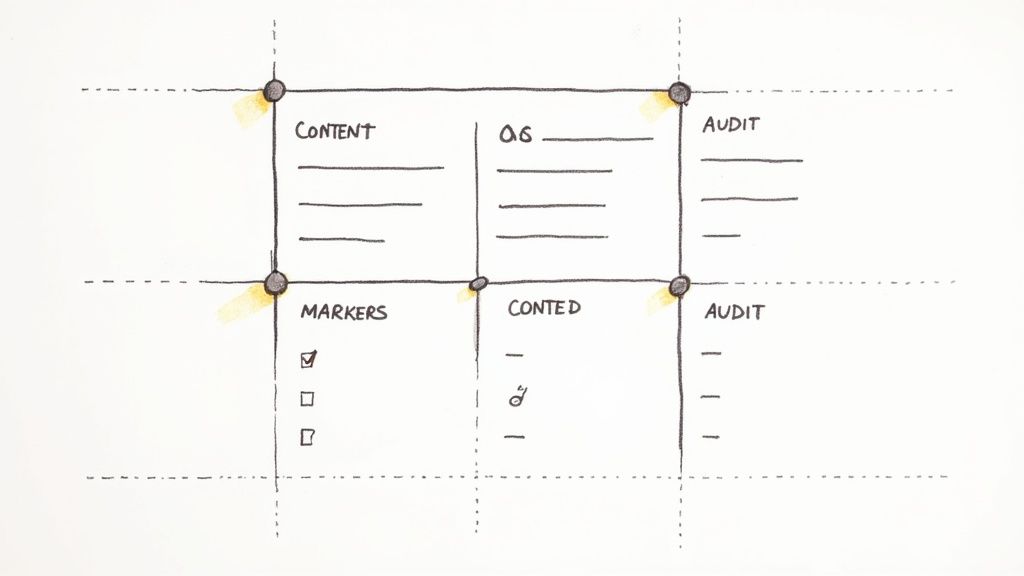Essential Website Content Audit Template for SEO


Why Content Audits Are the Secret Weapon of Top Websites
Websites, much like libraries, accumulate content over time. However, unlike a well-organized library, website content can become cluttered and outdated, hindering performance. This is where content audits come into play. A content audit is a comprehensive evaluation of all the content on a website. It's like taking inventory of your website's library to determine what's effective, what's not, and what's missing.
This process reveals opportunities to enhance existing content, eliminate outdated materials, and strategically plan for new content creation. By aligning your content with your business objectives, you can drive better results.
The Power of Regular Audits
High-performing websites recognize that content audits aren't a one-time task. They are integral to a successful content strategy. Regular audits keep your website current, relevant, and engaging for your target audience.
For example, a website selling seasonal products needs frequent updates to product pages and blog posts to reflect current trends and offerings. Regular audits also identify and resolve technical issues like broken links and slow loading speeds, both of which can negatively affect search engine rankings and user experience. This ongoing maintenance is essential for a healthy, high-performing website.
Moreover, regular content audits have become even more critical with Google's focus on content quality and freshness. Google's Quality Rater Guidelines underscore the importance of prioritizing recent, updated information for higher rankings. Websites that refresh their content regularly see an average 20% increase in organic traffic within a year after the audit. For more detailed information, visit: Learn more about content audits.
Uncovering Hidden Opportunities With a Website Content Audit Template
A highly effective method for conducting a content audit is using a website content audit template. This provides a structured approach for gathering and analyzing website content data. A good template includes key information such as page URLs, content type, keywords, traffic data, and conversion rates.
This organized approach streamlines the audit process and reveals patterns and trends in your content's performance. For example, you may discover that blog posts with a specific keyword generate significantly more traffic, highlighting a potential area to focus on for future content. Using a template transforms raw data into actionable strategies for optimizing your content.
Building Your Website Content Audit Template That Actually Works

Creating a website content audit template that truly delivers goes beyond a basic spreadsheet. It requires a structured approach to collecting insightful data and using it to shape strategic decisions. This means creating a template that includes both performance data and qualitative assessments.
Key Components of an Effective Template
Effective content teams recognize the value of a well-organized website content audit template. They incorporate several key elements to get a complete picture of their content's strengths and weaknesses.
-
Content Inventory: This section focuses on listing your existing content. It should include essential details such as URLs, content types (blog posts, landing pages, product descriptions, etc.), and word counts. Think of it as a comprehensive map of your content landscape.
-
Performance Metrics: This is where you dive into how your content is performing. Track metrics such as traffic patterns (pageviews, unique visitors), conversions (leads generated, sales made), and engagement (bounce rate, time on page, social shares). These metrics provide valuable insights into user behavior and content effectiveness.
-
Quality Indicators: This section goes beyond numbers to evaluate the overall quality of your content. Include factors like relevance (how well content aligns with target keywords and user needs), accuracy (ensuring information is current and factual), and completeness (checking for broken links, missing images, or outdated details).
To better understand the necessary components, let's examine the following table:
Essential Content Audit Template Elements
A comprehensive breakdown of must-have components for any content audit template, categorized by content inventory, performance metrics, and quality assessment factors.
| Component Category | Key Elements | Why It's Important | How to Measure |
|---|---|---|---|
| Content Inventory | URL, Content Type, Word Count, Author, Publish Date | Provides a complete overview of existing content and allows for easy organization and identification of content gaps. | Website crawler, CMS data export |
| Performance Metrics | Pageviews, Unique Visitors, Bounce Rate, Time on Page, Conversion Rate, Social Shares | Helps identify top-performing content, understand user behavior, and uncover opportunities for improvement. | Google Analytics, social media analytics tools |
| Quality Indicators | Relevance Score, Accuracy Check, Completeness Measure, Readability Score, SEO Performance | Ensures content is high-quality, meets user needs, and aligns with business objectives. | Manual review, SEO tools, readability checkers |
This table summarizes the core components of a content audit template and explains their significance. Each category plays a vital role in gathering a complete picture of your content's performance and identifying areas for optimization.
Customizing Your Template For Success
While the fundamental components are consistent, the most effective website content audit templates are tailored to specific business requirements. Your goals, website structure, and target audience should all inform the final design of your template. For example, an e-commerce site might prioritize conversion data, whereas a blog might focus on engagement metrics. This customization ensures you collect the right data to guide your content strategy.
Using tools like Google Analytics is essential for analyzing page performance. Establishing benchmarks for pageviews, bounce rates, and average time on page helps pinpoint underperforming content. For instance, a page with fewer than 100 pageviews over a year and a high bounce rate exceeding 80% might indicate a need for revisions or removal. Learn more about website statistics: Find more detailed statistics here. You might also find this helpful: How to master a Website Audit Checklist. These insights can help refine your template and focus your audit on making impactful changes. A well-designed template enables you to analyze your content comprehensively and make informed decisions based on data.
Implementing Your Audit: From Planning to Action

Turning a content audit from a complex undertaking into a manageable project begins with careful planning. This involves defining the scope of your audit, setting clear objectives, and establishing measurable benchmarks. It's similar to planning a road trip: you need a destination (objectives), a route (scope), and an estimated travel time (benchmarks).
Defining the Scope and Objectives
First, decide which sections of your website need auditing. Will you examine the entire site, a specific section (like your blog), or a particular content type (such as product pages)? This clarity is vital for allocating resources and setting realistic deadlines. For instance, auditing a large e-commerce website with thousands of product pages will naturally take longer than auditing a small blog.
Next, establish your objectives. Do you want to improve SEO performance, increase user engagement, boost conversions, or update outdated content? Each objective necessitates a different approach and uses different metrics. An SEO-focused audit will prioritize keyword rankings and backlinks, while a conversion-focused audit will examine click-through rates and lead generation.
Establishing Benchmarks and Collecting Data
Before starting, set clear benchmarks for your key metrics. This involves understanding your website's current performance for metrics like organic traffic, conversion rates, and bounce rates. These initial figures provide context for your audit findings and help measure the impact of any subsequent changes.
Collecting content data is the next essential step. Gathering information efficiently is key to avoiding getting lost in spreadsheets. Website crawlers can automate the collection of URLs, metadata, and other data points, saving valuable time and effort. ContentKing offers automated data collection and real-time website content monitoring, automatically pulling metadata like title tags and meta descriptions and tracking updates. This is especially helpful for websites with extensive content libraries, ensuring everything is current and optimized for search engines. For more information on content audits, you can discover more insights here. Those interested in competitor analysis might find this resource on competitor website analysis tools useful.
Analyzing and Evaluating Content
With data in hand, you can start analyzing and evaluating your content. This involves examining metrics such as pageviews, bounce rates, time on page, and conversion rates. Remember to also evaluate the quality of your content, considering factors like relevance, accuracy, and readability. Think of a recipe website: pageviews are important, but the quality of the recipe and its instructions are critical for user satisfaction.
Practical Tips and Strategic Shortcuts
Experienced content professionals know how to efficiently scale the audit process for larger websites. They often use a phased approach, dividing the audit into smaller, manageable parts. Leveraging automation tools and standardized procedures further streamlines the process, ensuring the audit remains manageable and delivers actionable insights. Just like building a house—you wouldn't build every room at once.
Applying Evaluation Criteria and Resource Allocation
Applying the right evaluation criteria to different content types is vital. A product page will be evaluated differently than a blog post. Product pages should focus on clear descriptions, high-quality images, and strong calls to action, while blog posts should prioritize engaging writing, relevant keywords, and social sharing. Effective resource allocation, including time and personnel, is essential to keep the audit on track and within budget, ensuring the audit is a strategic investment in your website's success, not an overwhelming burden.
Tools That Make Your Content Audit Smarter, Not Harder

Manually collecting data for a website content audit can be a tedious and time-consuming process. Fortunately, several tools are available to streamline this process, transforming your website content audit template from a static document into a dynamic hub of strategic insights.
Analytics Platforms: Understanding Content Performance
Analytics platforms like Google Analytics are crucial for understanding your content's performance. They offer valuable data, including pageviews, bounce rates, time on page, and conversion rates. This data helps identify high-performing content and areas needing improvement.
For example, a high bounce rate combined with low average time on page might suggest the content isn't engaging. This insight, coupled with your website content audit template, informs decisions about revising or removing content.
SEO Tools: Finding Keyword Opportunities
SEO tools like Semrush, Ahrefs, and Moz offer features to enhance your content audit. These tools analyze keyword rankings, identify backlink opportunities, and assess your website's overall SEO health.
They can also help uncover content gaps and keywords your competitors are ranking for. Integrating these insights into your template helps identify opportunities to optimize existing content and create new content targeting valuable keywords.
Content Quality Analyzers: Refining Your Content
Several tools specialize in analyzing content quality. These tools assess readability, identify grammatical errors, and offer suggestions for improving clarity and engagement. Examples include Grammarly and Hemingway Editor.
These tools are particularly useful for pinpointing content requiring revisions. They also help ensure your content aligns with brand voice and style guidelines, promoting consistency across your website. This strengthens your content audit by focusing on the user experience.
Building an Efficient Toolset
The right tools for your content audit depend on several factors, including website size, content volume, and audit objectives. Premium tools often offer advanced features, while free alternatives can provide comparable value for smaller websites or limited budgets.
Carefully consider your needs and budget. A well-chosen toolset streamlines your workflow, providing actionable data without unnecessary complexity or expense. It's like equipping a kitchen – you don't need every gadget, just the right ones for efficiency.
Turning Audit Insights Into Content That Performs
A website content audit is only as valuable as the actions it generates. Collecting data is just the first step. The real power lies in transforming these insights into a content strategy that drives results. This section shows you how to bridge the gap between data and action, turning your audit findings into a prioritized content roadmap.
Categorizing Content and Prioritizing Actions
Analyzing your audit data requires a systematic approach. Start by categorizing your content into distinct action buckets.
-
Preserve: This category contains your highest-performing content—the pieces driving traffic, engagement, and conversions. While these require minimal changes, monitoring their continued performance is essential.
-
Refresh: Content in this category has potential but needs updating. This could involve refreshing outdated data, improving readability, or optimizing for specific keywords.
-
Overhaul: Underperforming content needing significant revisions falls into this category. Consider rewriting sections, adding visuals, or restructuring the entire piece.
-
Consolidate: If your audit reveals duplicate content or multiple pages on similar topics, consolidation is essential. Merge the strongest elements into a single, comprehensive piece and redirect other URLs.
-
Remove: Some content simply doesn't serve a purpose. If a page has low traffic, no backlinks, and isn't relevant to your audience, removing it entirely might be the best option.
To streamline your content audit process, consider using dedicated customer feedback collection tools. Gathering direct input from your audience can provide valuable context and inform your content decisions.
The following table provides a strategic framework for deciding what actions to take based on content performance and quality.
Content Decision Matrix: A strategic framework for determining what actions to take with different types of content based on performance metrics and quality assessment.
| Content Performance | Content Quality | Recommended Action | Priority Level |
|---|---|---|---|
| High traffic, high conversion rate | Excellent | Preserve | Low |
| Moderate traffic, declining engagement | Good, but outdated | Refresh | Medium |
| Low traffic, low engagement | Poor | Overhaul/Consolidate | High |
| Very low traffic, no conversions | Irrelevant | Remove | High |
As you can see, prioritizing actions involves balancing potential impact with the effort required. Addressing high-performing but slightly outdated content often yields greater returns than overhauling low-traffic pages.
Building a Prioritization Framework
Leading content teams use prioritization frameworks to balance effort against potential impact. This ensures maximum ROI from your post-audit activities. For example, refreshing a high-traffic page with outdated information is likely more impactful than overhauling a low-traffic page.
Creating Actionable Timelines and Assigning Responsibilities
Once priorities are set, establish realistic timelines. Break down large tasks into smaller, manageable steps, assigning responsibilities across your team. This promotes accountability and keeps the project on track.
Measuring Impact and Following Up
Follow-up is crucial. Track how content changes impact key performance indicators (KPIs). For instance, if you refresh a blog post, monitor its organic traffic, bounce rate, and time on page. This data provides valuable insights into the update's effectiveness. You can learn more about improving website performance in our article about How to Master Website Conversion Optimization.
Turning Insights Into Success: Case Studies
Many organizations have achieved significant results by translating audit insights into effective content strategies. One company saw a 30% increase in organic traffic after refreshing its top blog posts with updated information and keyword optimization. Another company improved its conversion rate significantly by consolidating duplicate product pages and strengthening calls to action. These examples highlight the potential of a well-executed content audit.
Creating Your Sustainable Content Audit Schedule
A website content audit template provides the structure, but a sustainable schedule ensures your website's long-term health. Just like regular health checkups, routine content audits keep your website performing at its best. This section helps you build a content audit schedule that works with your resources.
Factors Influencing Audit Frequency
Several factors influence how often you should conduct content audits. Understanding these elements helps determine the ideal frequency for a deep dive into your content’s performance.
-
Website Size: A small blog might only require an annual review. A large e-commerce site with thousands of pages could benefit from quarterly or even monthly checks. Think of it like cleaning your house: a studio apartment needs less frequent cleaning than a large house.
-
Content Publication Volume: If you publish new content daily, more frequent audits ensure your content strategy stays on track.
-
Industry Competitiveness: In fast-paced industries, regular audits help you stay ahead of competitors and adapt to evolving trends. The fashion industry, for example, demands constant updates due to rapidly changing trends.
-
Team Capacity: Consider your team's bandwidth and resources. A smaller team might spread audits throughout the year, focusing on specific sections at a time.
Implementing Different Audit Types
There’s no one-size-fits-all approach to content audits. Varying the types and frequency keeps your content strategy dynamic and adaptable.
-
Comprehensive Annual Audit: This in-depth audit examines your entire content library. It acts as your yearly content inventory check, allowing you to identify overarching trends and weaknesses.
-
Focused Quarterly Reviews: Concentrate on specific sections or content types each quarter. For instance, review blog posts in Q1, landing pages in Q2, and product pages in Q3.
-
High-Traffic Page Monitoring: Regularly monitor your top-performing pages to ensure they remain relevant and effective. This proactive approach prevents minor issues from becoming major problems.
Ongoing Monitoring Between Audits
Scheduled audits are important, but ongoing monitoring is crucial for catching issues early and preventing small problems from escalating. It's like regularly checking your car's oil to prevent future engine trouble. Use website analytics tools like Google Analytics to track key metrics and identify sudden drops in traffic or engagement. Set up automated alerts for significant changes, enabling quick intervention.
Integrating Audits Into Workflows
Integrate content audits into your regular workflow to make them a manageable, ongoing process, rather than a daunting annual project. This transforms auditing into a continuous improvement strategy. Think of it like incorporating exercise into your daily routine – it becomes a habit. For example, review a few key pages during your weekly content planning meetings. This ensures regular attention to your content's performance.
Scaling Your Audit Process
As your website grows, your content audit strategy must also evolve. Consider automated tools and refine your website content audit template for a larger content library. Delegate tasks efficiently and establish clear workflows. This allows your audit process to scale seamlessly with your website's growth, similar to building scalable business infrastructure.
Don't let your website content become a liability. Start improving your website today with Roast My Web's AI-powered website auditing tool, designed for agencies and freelancers. Get actionable insights and generate client-ready reports effortlessly. Start your free trial now!